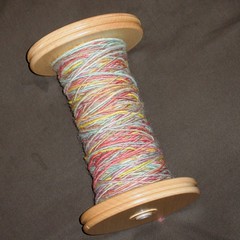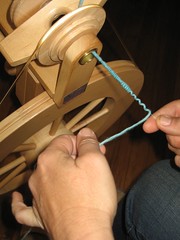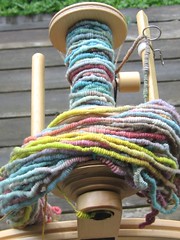



I've been spinning a lot of my own supercoils, my LoopyDoopy yarns, in preparation for vending at Black Sheep Gathering in June, and today I pulled another skein off the bobbin. I've always wondered what the ratio of singles to plied supercoils is, so when I finished a bobbins worth of singles, I skeined and measured them before plying. I'd read in Symeon's Knittyspin piece that you need to spin about 7-10 times more singles than you want for your finished coils; she says it takes between 75 and 100 yards of singles for 10 yards of coils. But I found that the singles I measured was only 5x longer than the finished yarn; I spun 150 yards of singles, and plied them into approx. 30 yards of LoopyDoopy Minis coils. That was good news for me, 'cuz I'm getting more yardage out of my singles than I thought. Here's some shots of 'Route 66' that I've been working on (the colors reminded me of my time traveling in the Southwest, when I was living at Grand Canyon National Park, hence 'Route 66'.)
*(Personally, I suspect that the real reason that her technique reduces twist is because she spun Z and plied S, rather than the reverse, which is more common; most commercial threads and yarns are spun S, so Z plying will undo the twist, in my experience, causing the problems that both of these techniques alleviate. I get soft and balanced coil yarns without either of these strategies).
Tags:

Love your coils! And the stats on singles seem to match up with the "magic number" in my head for loop boucles', which is that you need 4 x the length of singles for the loopy single than you want your final yarn to be.
ReplyDeleteI've seen Sarah's technique in action ... I think the uniqueness of it is the untwisting of the core that she's doing, using the spindle. It's *really cool* to see in person, though I admit I haven't tried it myself. I hear she's teaching it at SOAR as well as in the local area here (WA state), so it'll be interesting to see what others think as it gets more exposure.
My favorite coiling method is to coil alternatively with one single or the other, spacing an inch or so of coils by a foot or so of regular 2-ply, so I don't have to worry about thread twist direction and I can balance the impact of the coils on each of the singles.